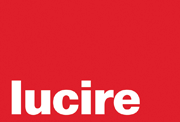| The (Chilean) hills are alive
As you progress further south into Chile’s “lake
district” (sometimes known as northern Patagonia, though geography
purists may dispute this nomenclature), the landscapes and architecture
become more definitively Germanic in their appearance. This was
shaped by a wave of immigration from Europe in the wake of the 1848
revolution in the German states. The main settlements, along with
their architectural and culinary legacies, can be found throughout
the area in such villages as Puerto Varas, Frutillar, and Puerto
Montt. The Museo Colonial Alemán in Frutillar brings to life the
ways in which settlers made their fortunes in the New World, as
well as offer spectacular views of the landmark Mt Osorno volcano from its hillsides.
Cafés in Puerto
Varas and Frutillar are distinguished by signage effortlessly blending
Spanish and German words. German and Swiss culinary and design influences
distinguish Hotel Patagonico in Puerto
Varas, which blurs the lines between function and luxury. The same
can be said about its wonderful cuisine, which is elegant in its
presentation but heartier in its composition. Salmon from local
waters cook up into rich, satisfying dishes that pair with Chilean
red wines as well as craft beers, many of which are made in the
German brewing traditions. The hotel bar also blends Chilean and
Germanic food culture deftly with the way they bring unexpected
flavours such as ginger and green apple into their Pisco sours.
continued below
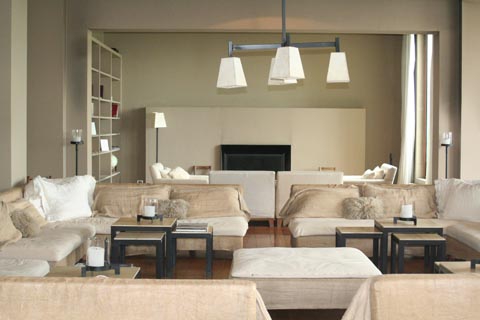
Perhaps the most visible—and refreshing—impact
German settlers made on regional cuisine is through its beer, where
old-world brewing traditions are shaped by Chile’s geographic attributes.
Kunstmann Brewery is the best-known craft (or artesanal) brewery,
while Austral is also popular and offers a Califate brew with subtle
hints of the indigenous berry.
However, there are many tasteful
reminders of the fact you are still in South America. Nearby fine-dining
restaurant Ibis offers a grapefruit Pisco sour made with Capel Pisco
that beautifully pairs with their signature salmon dish. Around
the corner, El Patio de Mi Casa features a raspberry sour that balances
out their substantial Chilean country comfort food.
Swiss-Chileans
(many who arrived through Valparaiso), not only had a knack for
trade, but tourism as well. In 1913, Ricardo Roth purchased and
transformed a transport company serving Chilean and Argentine traders
into a tourism company, sensing there would be a demand for adventure
travel in the coming years. His instincts continue to pay off, with
charismatic fourth generation hotelier Alberto Schirmer-Roth operating,
managing and constantly restoring the original Hotel Peulla (built
in 1896, and visited by John F. Kennedy and Franklin Delano Roosevelt,
among others) and the modern Natura Hotel. Both family-friendly
lodges offer excursions and activities (hiking, canopy tours, horseback
rides) that showcase Chile’s alpine geography.
Heading south for the winter
Punta Arenas and Puerto Natales are among the
southernmost cities on Earth, boasting an eclectic mix of nightclubs,
cultural tourist attractions and penguin colonies. However, if you
are looking to go to the ends of the earth in the name of adventure
and romance, Torres Del Paine National Park is where you will find
them.
This sprawl of geological wonder and extreme hiking heaven
is a four hours’ drive from Punta Arenas’ airport. Though Puerto
Natales is regarded as the gateway to Torres Del Paine and home
to several luxury and mid-priced hotels, the newly opened Tierra
Patagonia literally takes its visitors
to the edge.
Getting to Tierra Patagonia is an undertaking,
even with its drivers picking you up from Punta Arenas’ airport.
The jaunt involves a gorgeously austere four-hour drive, punctuated
by a lunch stop at roadside diner Rio Rubens, and, if time allows,
a quick stretch and photo at Puerto Natales.
However, you are richly
rewarded on your arrival. The sleek, earthy structure suddenly seems
to rise out of the ground. As you enter and check in, the sun is
starting to set against Torres Del Paine’s iconic “skyline” and
Lake Sarmiento. The entire public area of the property is bathed
in a warm pink hue.
Once you sign the paperwork and your suitcases
are whisked to your room, you are greeted with piping hot hors d’œuvres and your choice of a classic or calafate Pisco sour, which you enjoy
by a crackling fire. Manager Christopher Purcell, whose family is
behind this ambitious lodge (as well as the Tierra Atacama resort
in Chile’s desert north and the pioneering Portillo ski resort,
opened 1961), introduces himself to you, and then to a colleague
who will plan the activities for your stay based on your fitness
level and interests. She orients guests using a large, decorative
map of the park that dominates the living room that adjoins the
dining area. However before you decide which of the many hikes to
take, look out the window—which extends almost the entire expanse
of the property.
It suddenly hits you that you are in a place
like nowhere else. You are on the periphery of a spectacular natural
wonder largely undiscovered by most North American tourists, refreshingly
free of bars, souvenir shops and overpriced sporting goods’ emporiums.
Even if you may be missing out on some of Puerto Natales’ acclaimed
restaurants 90 minutes away, the kitchen (under the direction of
chefs Rafael Figueroa and Jaime Aguilera) strives to ensure guests
will be perfectly content with an ever-changing menu, blending locally
procured ingredients and some international culinary influences
(along with any dietary requirements). The ice cream and sorbets
are especially outstanding.
continued below
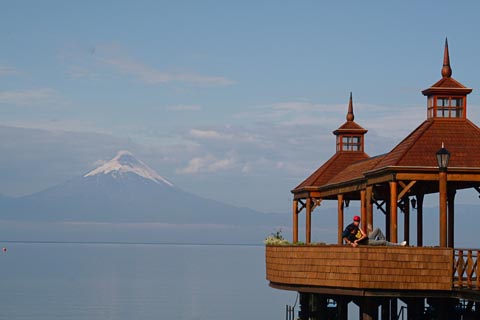
Learning about how this property came to be is
an adventure in itself, especially as Purcell described it. Though
the Tierra Patagonia project began in 2005, no detail was overlooked
and no expense spared. It took six years to for the Purcells and
their partners to conduct various environmental studies, obtain
government permits and ensure locals and authorities the structure
would harmonize with the tundra setting instead of jut out like
a proverbial 20-storey sore thumb.
‘While many properties have a
modern Scandinavian or Germanic feel, or pay a stylistic nod to
the German and Swiss settlements that had an impact on local culture
and cuisine, we wanted to do something very different than anything
else that had been done before,’ Purcell notes. ‘Most of the structure
is constructed with wood from the indigenous Lenga tree. We sourced
(much of) it locally from a sustainably managed forest. Instead
of clearing the forest, we hired a local construction company to
cut the upper branches, leaving as small a carbon footprint as possible. continued 1 | 2 | 3
|
 |
It suddenly hits you that you are in a place like nowhere else. You are on the periphery of a spectacular natural wonder largely undiscovered by most North American tourists, refreshingly free of bars, souvenir shops and overpriced sporting goods’ emporiums
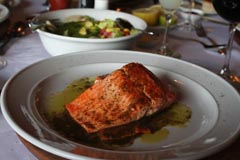
Salmon cooked by Hotel Patagonico

Flowers on the hike to Barraloche

Emu at the Puelle natural resort
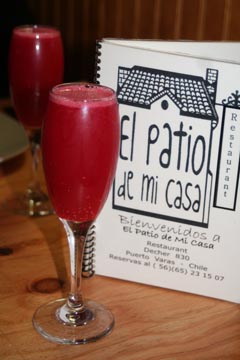
Raspberry Pisco sour
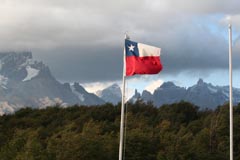
|
